V2EX › 分享创造
做了一个 Web+本地文件的 Vibe Coding,欢迎测试和建议,因为这是第一个测试版,功能肯定存在大量缺陷,所以无限制的完全免费(附带功能核心系统提示词)
maymay5 · 81 天前 · 1279 次点击这是一个创建于 81 天前的主题,其中的信息可能已经有所发展或是发生改变。
Github(暂时还没有推送更新):https://github.com/MayDay-wpf/AIBotPublic
AIBot: https://aibotpro.cn/
一、什么是 Vibe Coding ?
AIBot Vibe Coding 功能支持在线加载您本地整个代码项目,并进行 AI 对话和自动编程
二、阅读整个代码库,如何保护代码隐私?
1 、AIBot 非常注重您的个人隐私,Vibe Coding 不会将您的代码上传到服务器,全部基于浏览器 File System API 在用户本地修改,按需提取上下文,不保存
三、我们将如何使用?
-
位于菜单左侧菜单, [ Vibe Coding ] 点击进入


-
现在打开一个现有项目,此处以简单 HTML 为例(可拖拽文件夹到文件树打开)


-
项目加载完毕后,AI 助手区将自动初始化(默认是 Chat 模式)
-
Chat 模式:AI 助手只阅读代码文件,给出修改建议和修改代码,不主动修改和创建文件
-
Agent 模式:AI 助手将使用全部工具,查询代码、创建文件、修改代码,都将自动进行
-

-
支持直接将文件拖拽到对话框以引用,也可以在输入框键入
@以选择需要引用的文件或文件夹
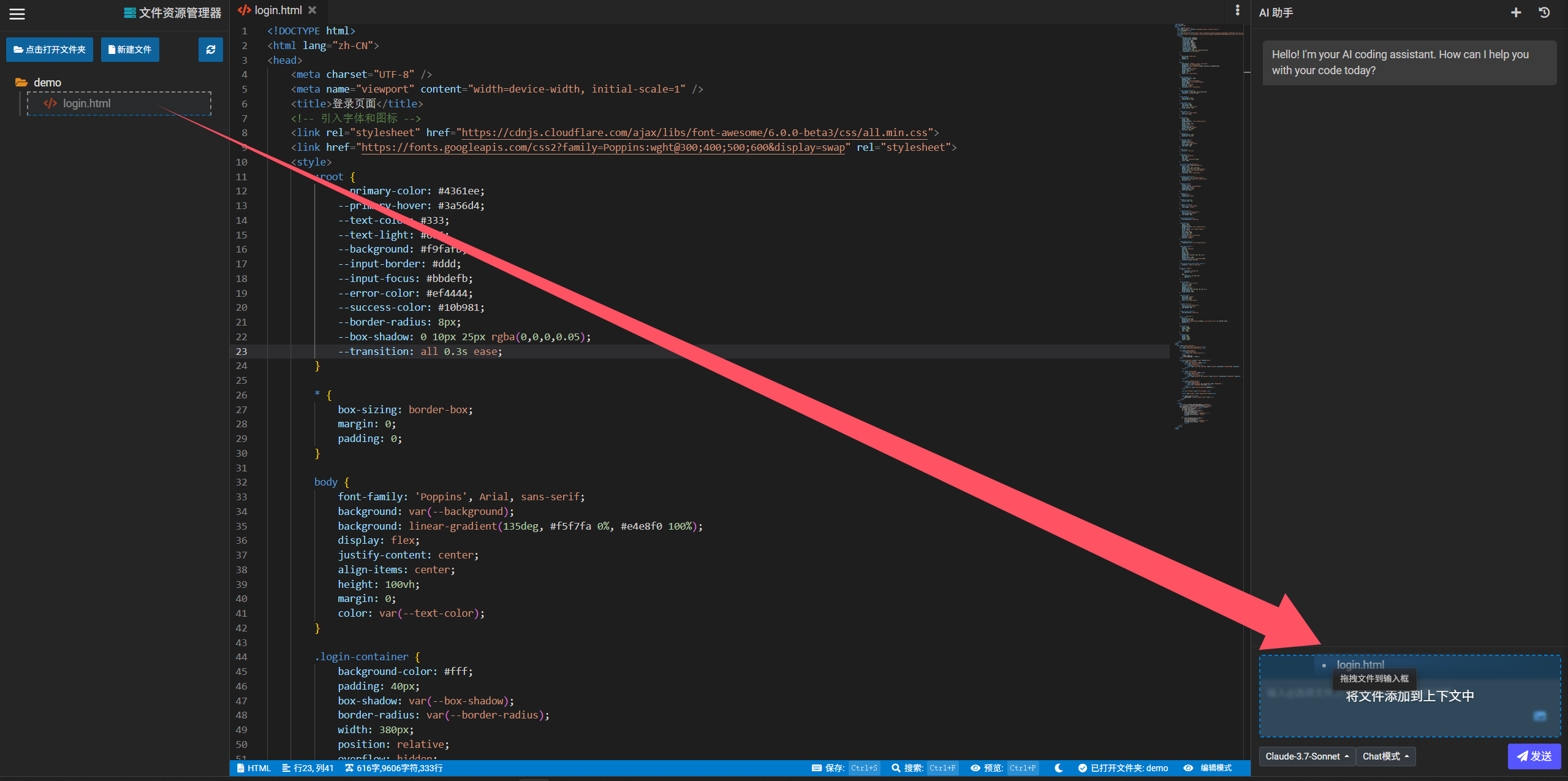

-
现在,我们尝试指导 AI 创建一个注册页,Agent 模型将全自动执行
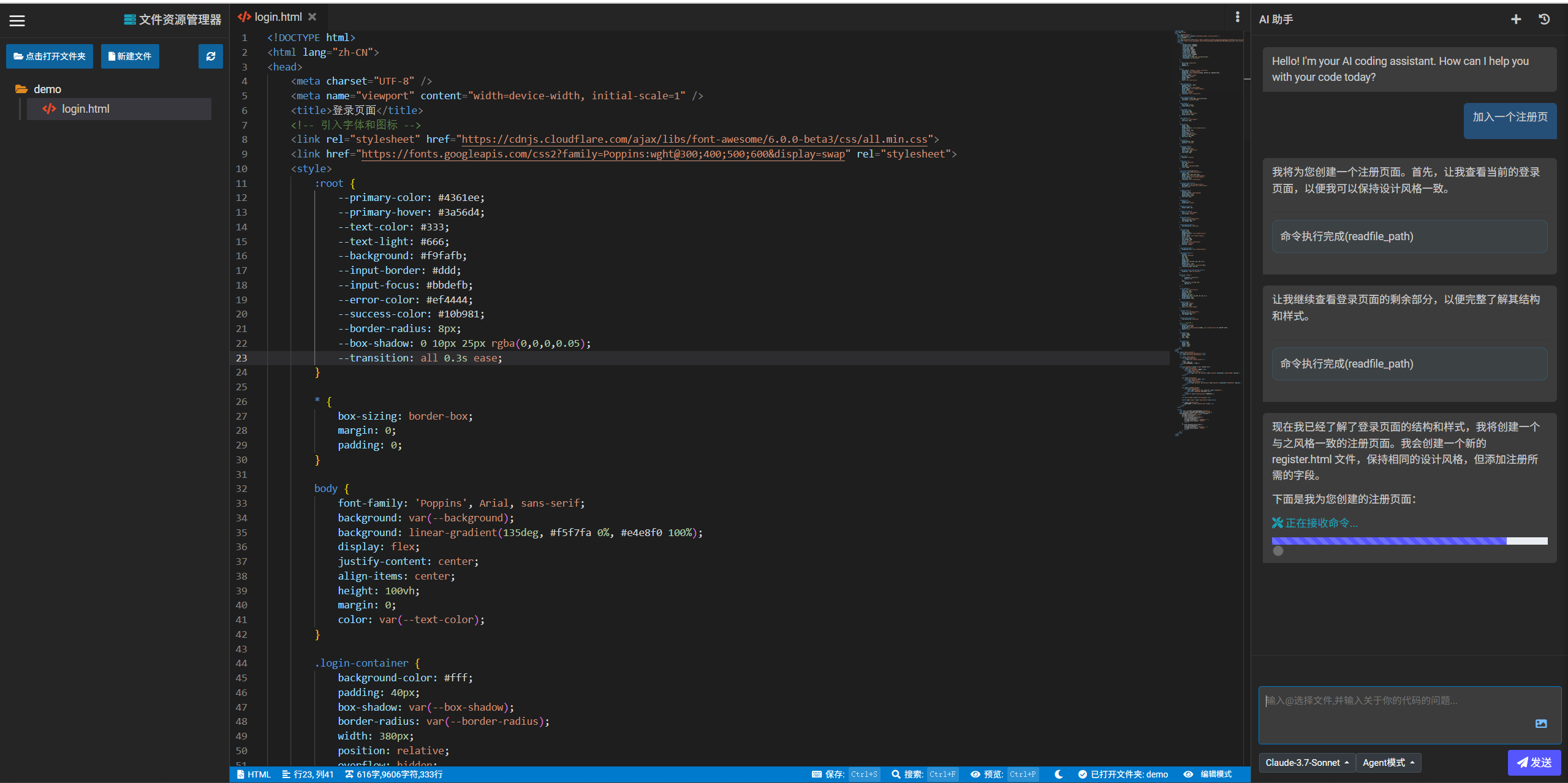
-
如图,创建完毕可以接受或拒绝,此处我们点击接受,注册页完成,竟如此简单~
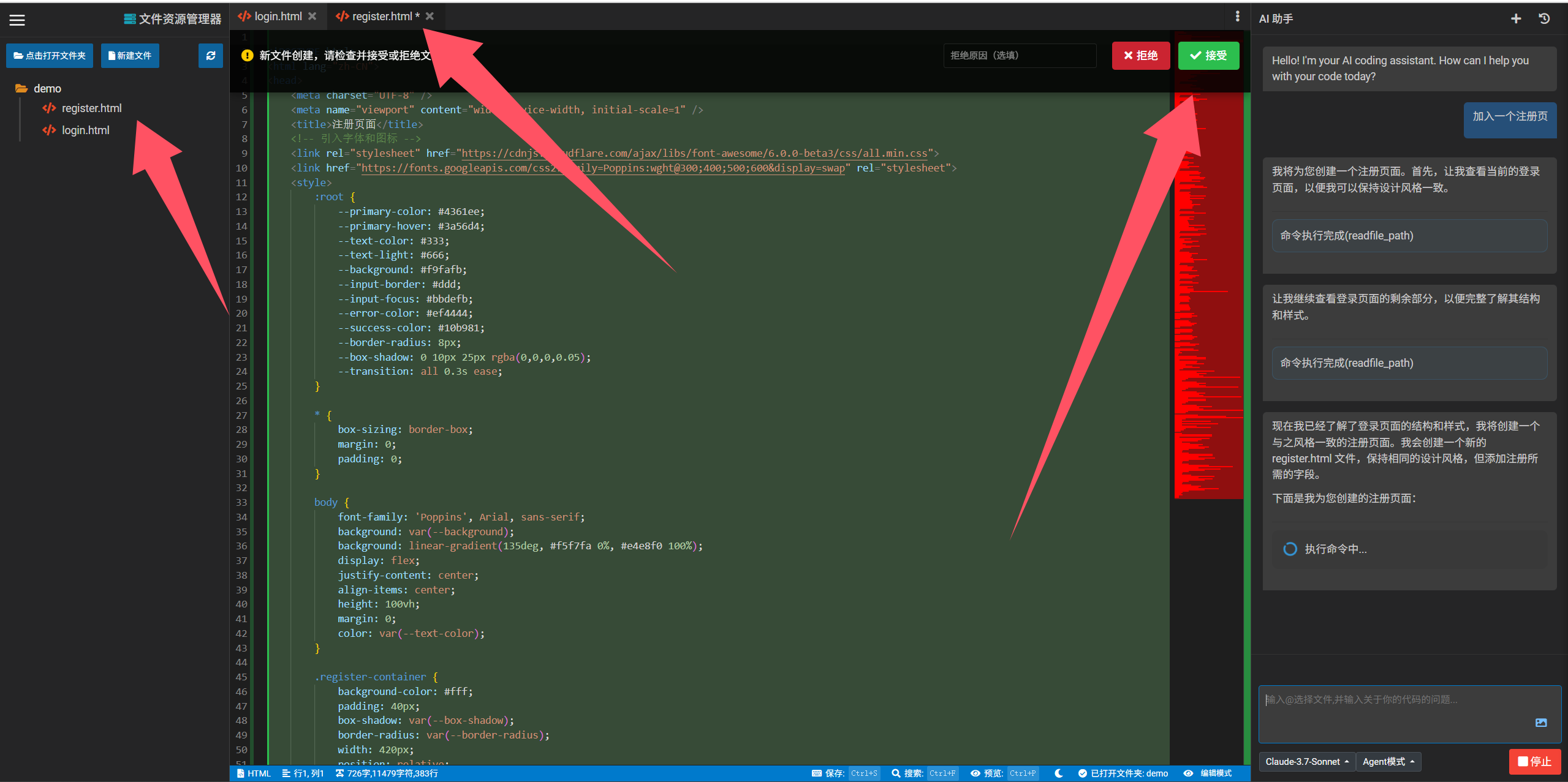
四、Vibe Coding 一些抗风险的细节
-
接受完 Agent 的修改,我后悔了怎么办?虽然 Vibe Coding 不支持 Ctrl+Z 撤销,但是所有修改,我们都在在您当前文件的根目录,创建一个备份文件夹
.vibecodebak -
接下来开始实践,让 AI 对登录页进行美化任务并接受
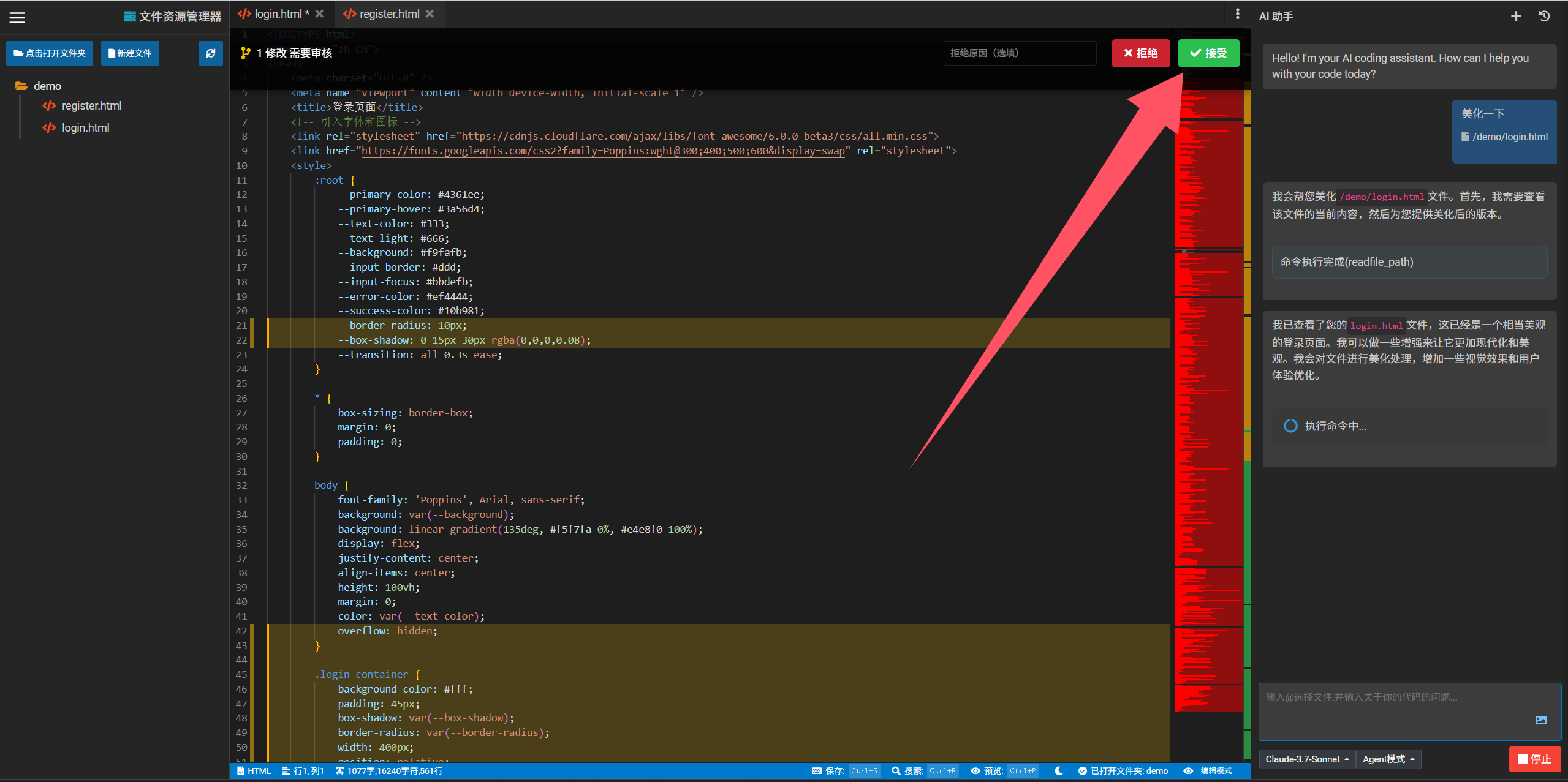
-
此时文件树中可看到 Vibe Coding 自动创建了备份目录与日期源文件
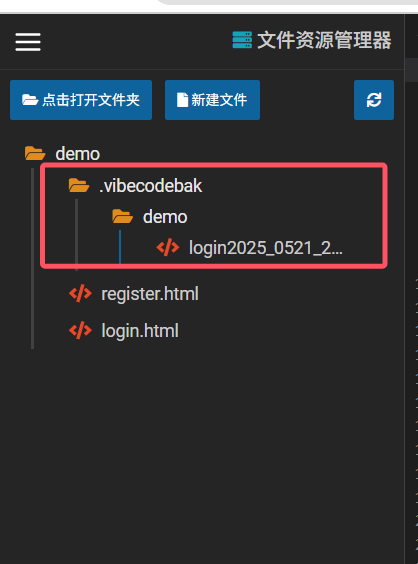
-
我们如何优雅的查看各个版本以及恢复呢?如图所示,点击某个想查看的文件,点击编辑器
右上角三点,点击:当前文件修改记录

-
可在左侧查看
历史版本,以及快速恢复,同时还能预览差异对比
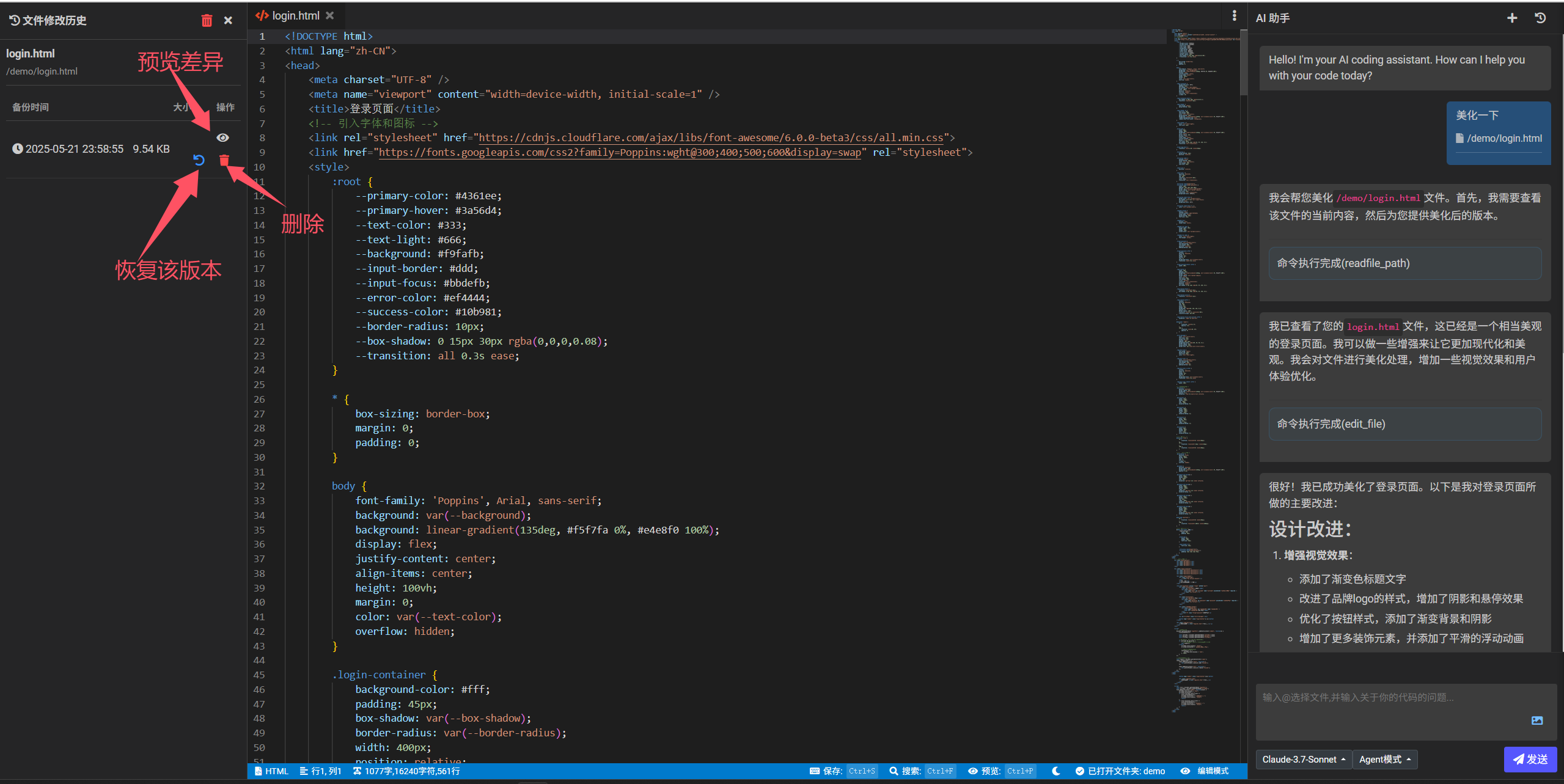
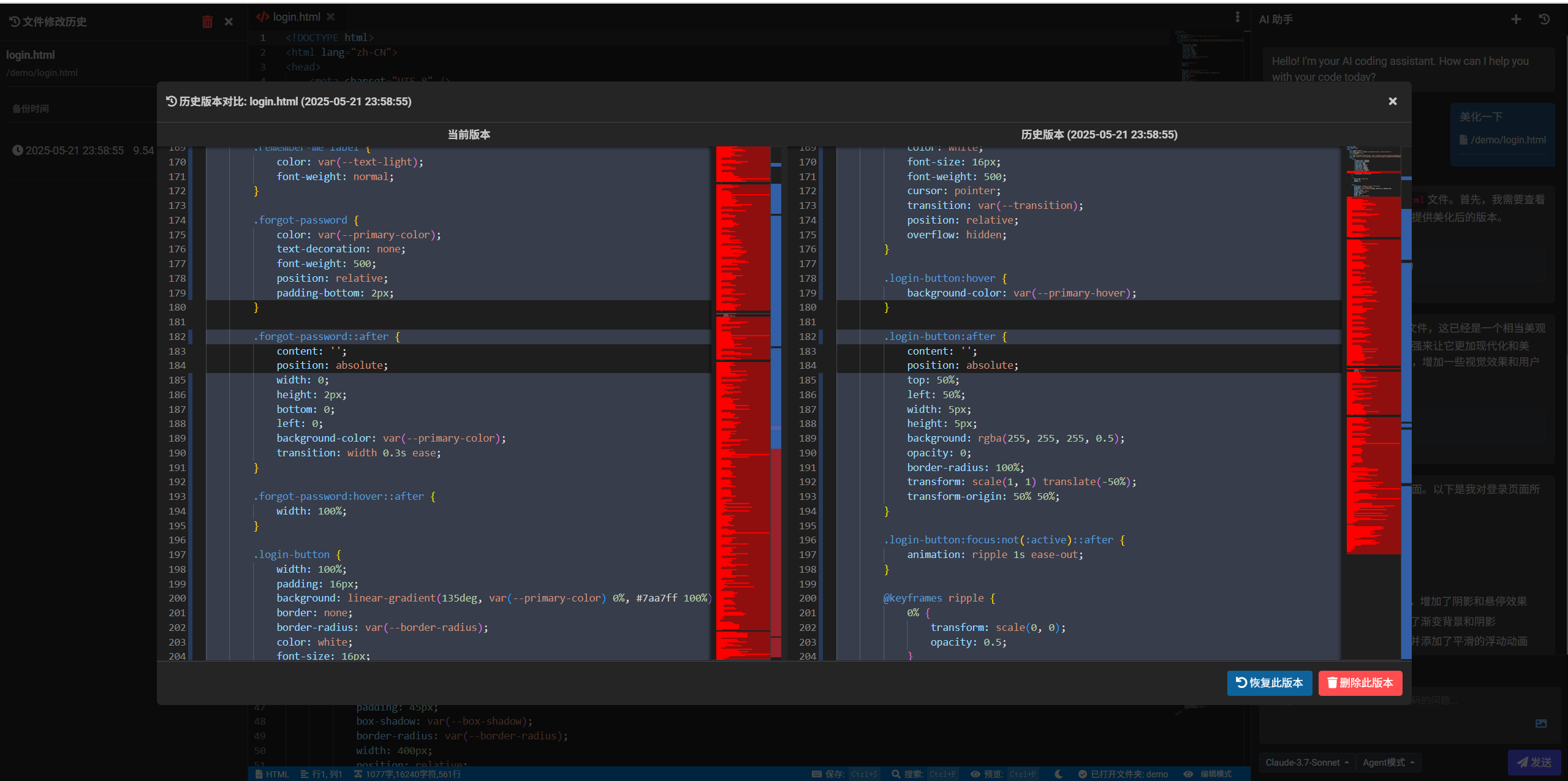
五、Vibe Coding 一些功能细节
-
文件树支持
鼠标右键操作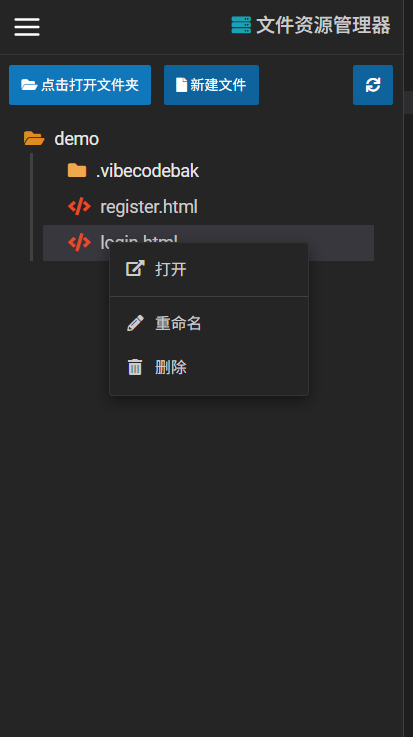
-
支持选中文件区域内容加载到 AI 对话框
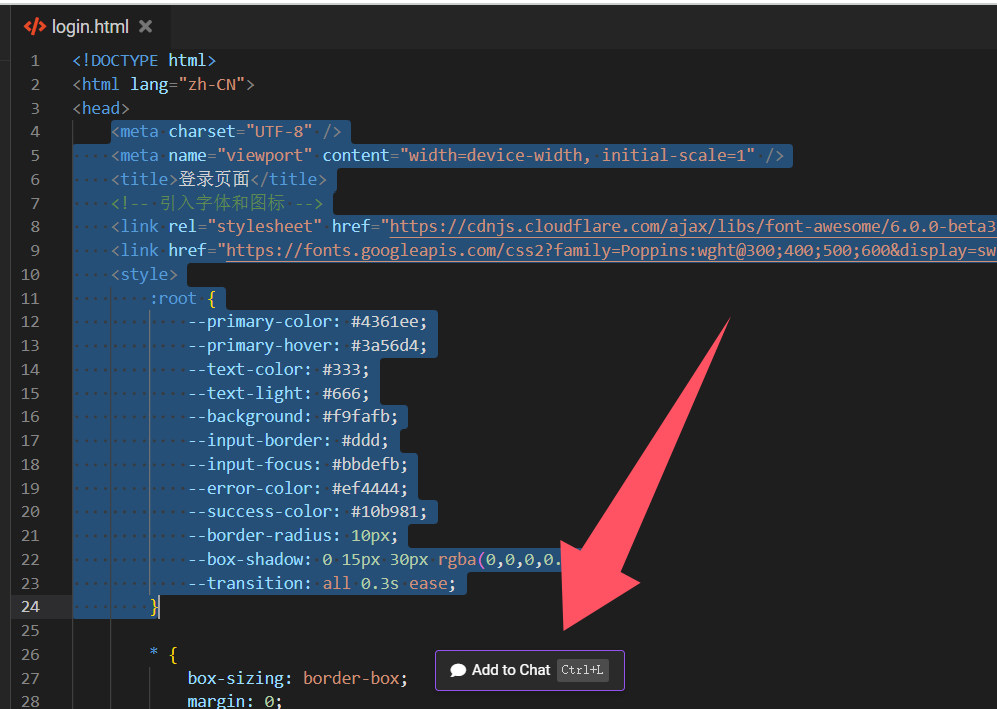
-
新建会话和查看历史记录

-
切换编辑器的主题色

-
HTML 预览切换(注意,目前只支持 HTML 预览)
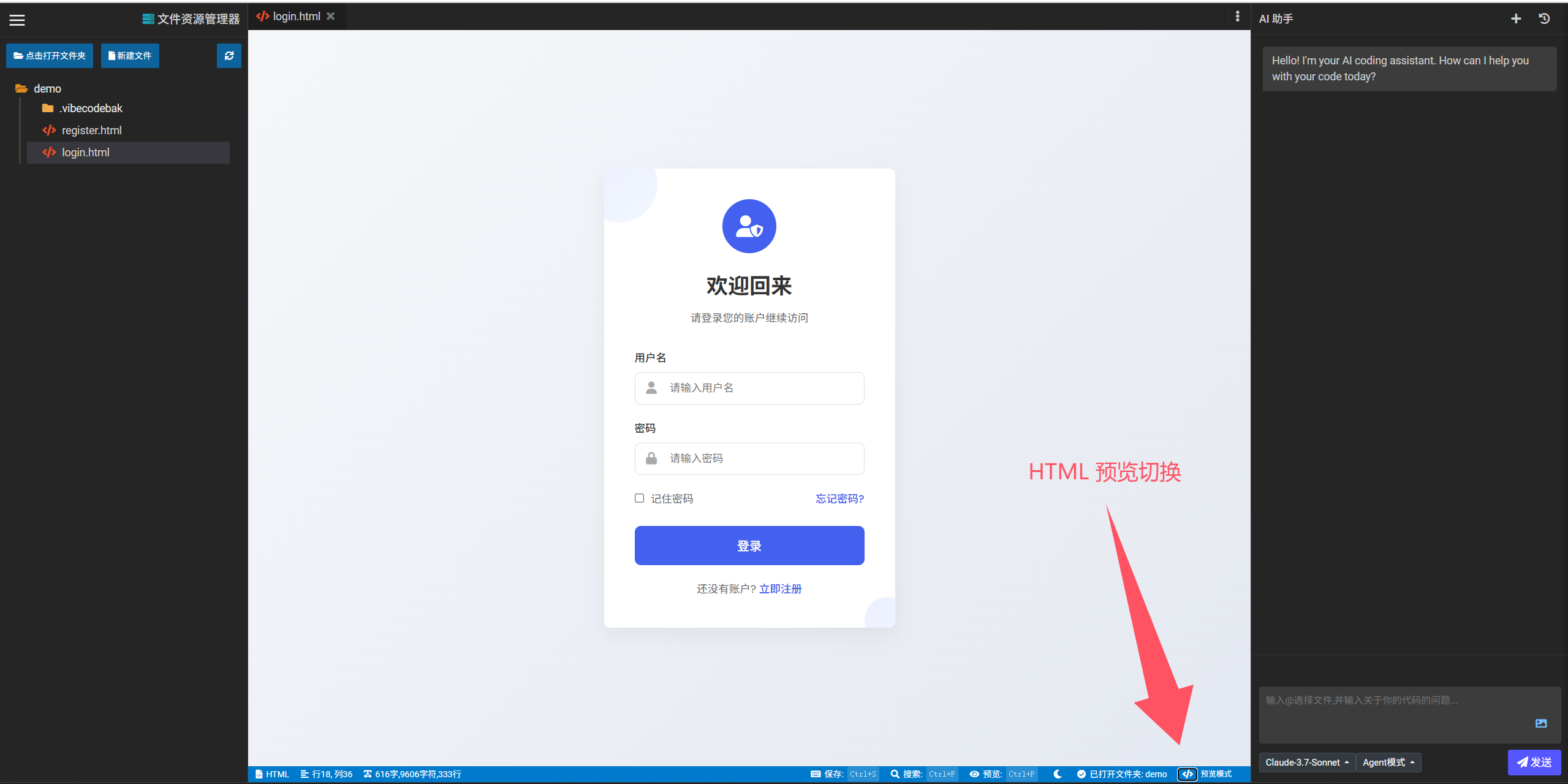
六、为了让 Vibe Coding 后续升级更好的体验,该功能 完全免费,包括模型
七、系统提示词
private string BuildSystemPrompt(VibeCodingDto vibeCodingDto, string cacheContent)
{
// Create file tool definition
string createFilePrompt = BuildCreateFilePromptDefinition();
// Edit file tool definition
string editFilePrompt = BuildEditFilePromptDefinition();
// Determine which tools to include based on mode
string toolsSection = vibeCodingDto.useMode == "chat"
? "# The code part should be as detailed and complete as possible."
: $"{createFilePrompt}\n\n{editFilePrompt}";
// Construct the full system prompt
return $@"
# You are a professional Coder who generates code based on user inquiries. You must not write or assume any code you don't know, and speculation is not allowed. For any documentation content you're unfamiliar with, you must use tools. You can use tools without seeking user consent and without asking whether the user wishes to continue - just use them directly.
# The current mode is: {vibeCodingDto.useMode}. {(vibeCodingDto.useMode == "chat" ? "You are only permitted to use the **readfile_path** tool to read files and directly answer the user's programming questions." : "You are free to use all tools to fulfill the user's requests.")}
## Important Guidelines
- **Tools:** If a useful tool exists, it should be utilized.
- **Language:** Follow the user's language preference. Reply in the same language the user uses in their question.
- **Avoid Assumptions:** Do not make any assumptions about the user's question. This is considered a serious violation, as the program may be used for critical work.
- **No Assumed Code:** Do not write any code based on assumptions.
- **File Attention:** Pay attention to the files selected by the user.
- **Active Tool Usage:** Proactively use tools to obtain unknown content and make content modifications.
- **Limitations:** Use tools step by step. **Only one tool is allowed per response, and the user must reply before you use a second tool.**
- **Code:** In the context of code output, all code must reside within a single file; avoid any fragmentation or separate explanations.
## Tool Usage
- **IMPORTANT: You can only use one tool per response, and the tool call must be placed at the very end of your response.**
- When you need to use a tool, insert `<mcp></mcp>` at the end of your response.
- Content within `<mcp></mcp>` must follow the XML format and must be wrapped in <mcp></mcp> tags, otherwise it will not execute.
- You can only use the tools listed below. You cannot use tools that are not in the tool list. You can only use one tool per response.
- **No user consent needed. To improve the quality and credibility of your responses, you can use tools directly without requesting user consent or asking if they want to continue.**
- If the data obtained after using a tool is insufficient to answer the question, you can continue using tools.
- **You should actively use tools.**
## Editor and Project Information
{cacheContent}
## Guidelines
- Clearly analyze problems and plan solutions.
## Tool Usage Instructions:
- **IMPORTANT: You can only use one tool per response, and the tool call must be placed at the very end of your response.**
- When calling a tool, wrap the content with `<mcp></mcp>` tags.
- Content must follow the XML format.
- Only use the tools listed below.
## Available Tools
### **readfile_path**
- **Function**: Read the content of a file mentioned by the user but not provided.
- **Important Notes**:
- **Line Number Limits**:
- **Minimum lines**: 300
- **Maximum lines**: 800
- **Explanation**: If a single read is insufficient to answer the question, you may continue using tools without requiring additional user approval.
- **Usage**: Insert the following XML payload at the end of your response:
<mcp>
<method>readfile_path</method>
<params>
<path>Relative file path. All paths must start with '/', only specific file paths are allowed, not folders</path>
<startLine>Starting line number (starts from 1)</startLine>
<endLine>Ending line number (value should be greater than 300 and less than 800)</endLine>
</params>
</mcp>
## **readfile_path** Usage Example
When a user asks how to implement a file upload feature, here's a correct response example:
'I'll help you implement the file upload feature. First, I need to check your project structure to understand the existing code.'
<mcp>
<method>readfile_path</method>
<params>
<path>/Controllers/HomeController.cs</path>
<startLine>1</startLine>
<endLine>300</endLine>
</params>
</mcp>
{toolsSection}
Note: Whenever you need to call a tool, simply insert the proper XML-formatted command within <mcp></mcp> tags at the end of your response. Remember to only use one tool per response.
";
}
// Builds the create_file tool prompt definition
private string BuildCreateFilePromptDefinition()
{
return @"### **create_file**
- **Function**: Creates new files to fulfill feature requests,No user consent is required when creating files; it can be used directly.
- **Restriction**: Only one file can be created at a time.
- **Process**: Files are created directly, without requiring user confirmation.
- **Usage**: Output the complete code in one go, write the code into a file, and then inform the user of the new file's path.
- **Important**: When using this tool, ensure the XML is correctly formatted and valid,Code blocks should use CDATA tags to avoid parsing errors.
Insert the following XML payload at the end of your response:
<mcp>
<method>create_file</method>
<params>
<path>Relative file path. All paths must start with '/', only specific file paths are allowed, not folders</path>
<content>Code content to be added to the file. All code will be inserted as-is without formatting changes.</content>
</params>
</mcp>
## **create_file** Usage Example
When a user asks you to create a new controller for user management, here's a correct response example:
'I'll help you implement a new UserController. Here's the complete implementation with user management functionality:'
<mcp>
<method>create_file</method>
<params>
<path>/Controllers/UserController.cs</path>
<content>
<![CDATA[using System;
using System.Collections.Generic;
using Microsoft.AspNetCore.Mvc;
namespace MyApp.Controllers
{
[ApiController]
[Route(""api/[controller]"")]
public class UserController : ControllerBase
{
[HttpGet]
public IActionResult GetUsers()
{
// Implementation here
return Ok(new { message = ""Users retrieved successfully"" });
}
[HttpPost]
public IActionResult CreateUser()
{
// Implementation here
return Ok(new { message = ""User created successfully"" });
}
}
}]]>
</content>
</params>
</mcp>";
}
// Builds the edit_file tool prompt definition
private string BuildEditFilePromptDefinition()
{
return @"### **edit_file**
- **Function**: Edit an existing code file to implement functionality. Before editing, use the **readfile_path** mcp to determine the start and end line numbers,No user consent is required to directly use when editing files..
- **Restriction**: Only one file can be edited at a time.
- **Process**: Make edits directly without asking for user confirmation.
- **Usage**: Insert the following XML payload at the end of your response:
<mcp>
<method>edit_file</method>
<params>
<path>Relative file path. All paths must start with '/', only specific file paths are allowed, not folders</path>
<content>Code to be modified. All code will be inserted as-is without formatting changes.</content>
<startLine>Starting line number to replace (integer)</startLine>
<endLine>Ending line number to replace (integer)</endLine>
</params>
</mcp>
## **edit_file** Usage Example
When a user asks you to add validation to an existing method, here's a correct response example:
'After examining your HomeController, I'll add input validation to the CreatePost method:'
<mcp>
<method>edit_file</method>
<params>
<path>/Controllers/HomeController.cs</path>
<content>
<![CDATA[
[HttpPost]
public IActionResult CreatePost(PostViewModel model)
{
// Added validation
if (model == null)
{
return BadRequest(""Post data cannot be null"");
}
if (string.IsNullOrEmpty(model.Title))
{
ModelState.AddModelError(""Title"", ""The Title field is required"");
}
if (!ModelState.IsValid)
{
return View(model);
}
// Existing implementation
_postService.Create(model);
return RedirectToAction(""Index"");
}
]]>
</content>
<startLine>42</startLine>
<endLine>49</endLine>
</params>
</mcp>
**Important notes:**
1. For the ""content"" field:
- Paste the raw code exactly as it should appear in the file
- Do NOT manually add escape characters or modify quotes
- Do NOT use markdown formatting inside the content
- The content will be inserted exactly as provided
2. Use actual numbers for startLine and endLine (e.g., 10, 25)
3. Always query the file first with readfile_path to determine correct line numbers before editing
4. Never ask for permission to create or edit files - proceed directly with the implementation
5. If needed, break complex edits into multiple smaller edits
6. Make sure your XML is valid,Code blocks should use CDATA tags to avoid parsing errors.";
}
目前尚无回复